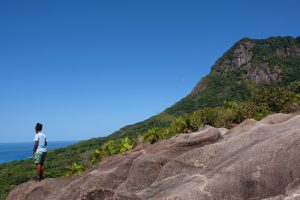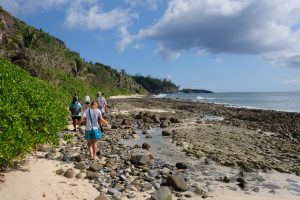
Guests at Hilton Seychelles Labriz Resort & Spa and environmental workers with Island Conservation Society reach Silhouette island’s crest en route to remote Grand Barbe beach, with 2,560ft-high Mount Dauban rising in the background.
Roll up your sleeves and lace up your hiking boots: this is no ordinary resort island. From beach clean-ups to bat patrols and giant tortoise sightings, every guest has a role to play in protecting Silhouette’s embattled, Edenic ecosystem
Read the article online at nationalgeographic.com
Rising like a rough-hewn emerald amid a binary world of open sea and unbroken sky, Silhouette’s golden fringes — sugary beaches spilling out into pearlescent, shallow reefs — reveal themselves only as our ferry draws closer. There’s a necklace of elegant villas decorating one bay, too. From afar, all is forest: luscious blankets of foliage spill down its granitic crags, clinging to sheer slopes beneath a jagged pinnacle: Mount Dauban. Curious seabirds attend our crossing from the mainland, now swooping high on thermals as we dock. From the water, Silhouette seems ancient and untouchable; but, on land, strident measures are being taken to protect an ecosystem in the balance.
Some 93% of this central Seychelles isle is designated as a national park and it’s encircled, too, by a protected marine reserve — beneath the glassy surface of the Indian Ocean, stirred up by warm trade winds, waters shiver with sharks and stingrays. I quickly discover there’s also a fitting humility to the island’s sole resort, Hilton Seychelles Labriz: while pirates, plantation workers and, now, pampered guests have, at different times over the centuries, called Silhouette home, nature has always been the headline act.
Now over a decade old, the hotel embraces this hierarchy, weaving its luxuries around the island’s own. On my first morning, I’m stirred awake by the chirps of bulbuls and must endeavour to dodge scuttling serrated mangrove crabs when cycling through the village of villas to breakfast. At dusk, as signature cocktails are served and gourmet dinners dished up, fruit bats with 3ft wingspans swoop overhead; and come nightfall, the resort wraps itself in a tropical, inky blackness, allowing the firmament to unveil countless constellations — and the faint twinkle of settlements on distant Mahé, the country’s main island. For many travellers, the resort and its sliver of eastern shoreline will offer enough diversion for a week or even two, but I’ve come to get my hands dirty, to muck in with Silhouette’s resident team of conservationists — and to see what else the island holds.
“A lot of people don’t want to do this on their holiday,” Nasreen Khan tells me shyly, handing out rubbish sacks to a gaggle of volunteers outside the hotel reception. The South African marine biologist heads up a team of four staff based here from Island Conservation Society (ICS), founded in the Seychelles in 2001. It’s 7am and the hotel is partnering with the environmental NGO for a monthly beach clean-up, sparing its staff and encouraging guests. “We also do litter picking as part of our daily wildlife patrols, but it’s great to get this many people involved,” Nasreen says, falling into lockstep with her colleague, Said Harryba, who grew up on the island. “You can achieve so much more when visitors get involved,” he adds.
A crocodile of 30 people crosses the perimeter of the resort, passing wild groves of mango and rose apple, towards the beaches of Anse Patates and Anse Lascar (the latter taking its name from the graves of early Arabic sailors found here; Lascar meaning ‘Arab’ in local parlance). As we hike over low, forested cliffs, the ocean reveals itself in dazzling flashes between fern fronds; on the beach natural debris is piled up like funeral pyres, from which we extract beer bottles, sea glass, flip-flops and fishing nets — a haul that, when weighed later, comes to 287lbs, about the weight of a cast-iron bathtub. “It’s not just what’s washed in; we’re unearthing things from old settlements, too,” says Nasreen.
The island has a curious history, one I learn more about when we meet up later at Gran Kaz, a museum and restaurant set in the ‘big house’ belonging to Silhouette’s 19th- and 20th-century plantation owners, the Daubans. Managed by Hilton, the two-storey, wooden structure stands just outside the resort in the sole surviving settlement of La Passe; today, the venue’s hosting its monthly Creole Festival which is a chance for visitors to engage with Seychellois traditions. Palm-leaf hats are woven, locally made jewellery sold, paintings exhibited, spicy octopus curry served, vanilla-laced rums tasted and — most spectacularly — centuries-old, African-inspired séga and moutya dances performed to the beat of drums.
“The songs were coded with messages the colonists couldn’t understand,” artisan Ingrid Saurer explains to me from across her stall of naturally sourced body scrubs and butters. “The dances were really made to be performed around a fire, if you can try to imagine that.”
Tragically, little is documented about the lives of African slaves on Silhouette — it’s thought that as many as 1,500 people lived and toiled here at the peak of the island’s industry, farming coconuts, vanilla and cinnamon, the population then slowly petering out after abolition in the 1830s. Instead, the exhibits in the house-museum display tales about the Dauban family, newspaper cuttings about 1950s treasure seekers and navigation logs dating back to the Seychelles’ annexation by France in 1756 — nearly 150 years after the uninhabited archipelago’s first recorded ‘discovery’ by the British East India Company.
I learn, too, that this island’s name wasn’t drawn poetically from its imposing outline (Mount Dauban, the islands’ second-highest peak, towers 2,560 feet high) but was given instead in supplication to a French finance minister, Étienne de Silhouette, during the reign of Louis XV. But as dusk descends on the isle once again and I walk barefoot along the beach among shadows cast by looming volcanic boulders, with the dark outlines of raptor-sized bats flitting silently overhead, Silhouette’s etymology seems fated.

A group of travellers, resort staff and enivronmental workers join forces for a monthly beach cleanup across the beaches of Anse Patates and Anse Lascar.
Over the top
My final full day on Silhouette with the ICS team is my most challenging. I’m joining them on one of their beach patrols, monitoring critically endangered hawksbill sea turtles who come ashore between October and March to nest — but first we must reach the far side of the island. The steep, sweaty hike from the resort, up and over a mountainous crest, is four miles long one-way and takes its name from the isolated beach we’re striking out to reach: Grande Barbe. The cove is also home to a dozen wild Aldabra giant tortoises, so the incentives to complete the hike are strong. But it’s the island’s most challenging trail and many travellers end up turning back, I’m warned — the jungle has been known to deal out injuries and exhaustion to the uninitiated.
When we embark in the cool hours of early morning, I’m in the safe hands of not only Nasreen’s team — today, including Jaymee Jumeau-Clarisse and Vanessa Dufrene — but also Labriz’s resident nature and hiking guide, Prajesh Mohandhas, who hails from southern India and has called the Seychelles home for a decade. “Put these in your pocket,” he instructs me, scooping three red Acacia Coral seeds from the earth, as we begin our ascent, and placing them in my palm. “They’re considered lucky — you might need them today!” Our group climb and climb, pausing in clearings every half-hour to catch our breath.
The forest contains multitudes. Prajesh points out endemic latanier palms, bulging jackfruits and tangled vanilla vines; then cracks open tamarind like a monkey nut and peels cinnamon bark with the tip of his machete, so I can better understand the smells of the jungle. We spot fat millipedes, skink lizards and spiky-limbed palm spiders suspended in gossamer webs. “What we want are long-term data monitoring sets,” Nasreen tells me, her unalloyed love of science making the meticulous and hard-won research sound wildly glamorous. She ticks off some of the projects they run: frog transects, insect audits, rare sheath-tailed bat patrols — all essential research into the stability of Silhouette’s ecosystem that, so far, is proving promisingly stable. The low-lying country as a whole, however, is on the very frontline of climate change, with coral bleaching, plastic pollution, overfishing and rising sea levels threatening its future, despite savvy government interventions.
“The staff and guests help us, too, reporting opportunistic sightings of wildlife to us. Because of the hotel, we’re better able to do our jobs. They support us — the hotel’s even building a bigger enclosure this week for the juvenile giant tortoises we’re safeguarding,” Nasreen says, as we snack on wild, bitter oranges during a sun-dappled break. I’ve seen this in action during my time on Silhouette: ICS use the cinema suite in the hotel for their nature talks and hop aboard snorkelling tours to conduct marine patrols. There’s a symbiosis, a joint dedication to preserving and restoring the island. Labriz’s resort manager, Thomas Porter, had shown me, proudly, the hotel’s mountain-water bottling plant; the grey-water filtration and recycling systems; and the organic gardens, swollen with watermelons and tended to by a dedicated farming team. “The less we import the better,” he said to me. “We’d like the international guests to think this way, too — to have an appetite for lowering their footprint here.”
Much of the passion, planning and innovation around conservation blossomed during lockdown. “Although we had almost no Covid-19 here, there were very few guests; for months at a time, it was just us staff. We realised it’s not enough just to appreciate the island — it’s our role to protect it, too,” general manager, Andre Borg, told me after my site tour. “We had to shift away from plastic use to help tackle the pollution. We couldn’t not, after seeing what was washing up — it changes you.”
Several hours into the hike something strange happens: we emerge from the forest into an alien landscape. Atop the island’s crest, the earth is rust-red, the foliage low and bleached — there’s no shade. The path swerves wildly up and over ancient rock formations so undulating it looks as if a giant hand had plunged into the land and kneaded it savagely. The sun is high in the sky and, when we reach the western lip of the ridge, Grande Barbe reveals itself below us: a half-mile smile of white sand, enclosed by cave-pocked cliffs and graced by a brackish inlet and lagoon. In the distance, we spot a speed boat — the hotel has motored out to collect us, saving us hiking the return leg. “We better get to work,” Vanessa says dryly, leading the descent.
On the beach, the ICS team unzip their rucksacks; withdraw clipboards, measuring equipment and a GPS locator; and instantly start assessing flipper patterns in the hot sand. “It’s difficult only coming to this side of the island just once a week,” Jaymee laments. “It means we’re now solving a puzzle with only faint clues.” The team move decisively along the shore, above the tide line, speaking quickfire: “We’ll mark this one down as just an emergence”; “This one’s too indistinct”; “It’s a nest — go into the bushes, you’ll see the digging more clearly”; “Measure the width of these tracks — is it a green turtle?” Ripples in the sand that look like nothing more than wind marks reveal complex histories under the forensic gaze of the biologists.
Before we pile into the waiting boat, we go to check in on the giant tortoises. They’re easily found lounging in what I’m told is their usual glade, among the ruins of what was once a thriving village. Some of the creatures are vast — almost 4ft long. Their lumpen shells are stone-solid, their facial expressions inscrutable. Vanessa greets one like an old friend, patting his carapace affectionately as she records his measurements; the tortoise remains placidly in place, jaws slowly masticating on fallen breadfruit. The fantastical 80-year-old reptile is categorised as ‘vulnerable’, due to human poaching and trade, but not ‘endangered’. In fact, a population of 100,000 exist in the Seychelles’ far-flung Aldabra atoll — an UNESCO World Heritage Site wilder than even Silhouette, with no jetty, airstrip or helipad. “If you think about it, that means there are more giant tortoises than people in this country,” Prajesh points out.
In the Seychelles, nature may be the headline act — but, as I’ve learnt, it still requires many helping hands.
How to do it
Kuoni offers five nights at Hilton Seychelles Labriz Resort & Spa in a Garden Villa and two nights at Hilton Seychelles Northolme Resort & Spa in a King Sunset Villa, both B&B. Selected departures in May 2022 are from £2,599 per person based on two people sharing. Price includes international flights on Emirates from London Gatwick.
The hotels are Green Globe certified; use the Hilton LightStay auditing programme to measure and manage energy, water and waste, and to forecast future consumption; and offer guests hands-on conservation experiences with Island Conservation Society and Marine Conservation Society Seychelles, respectively.

